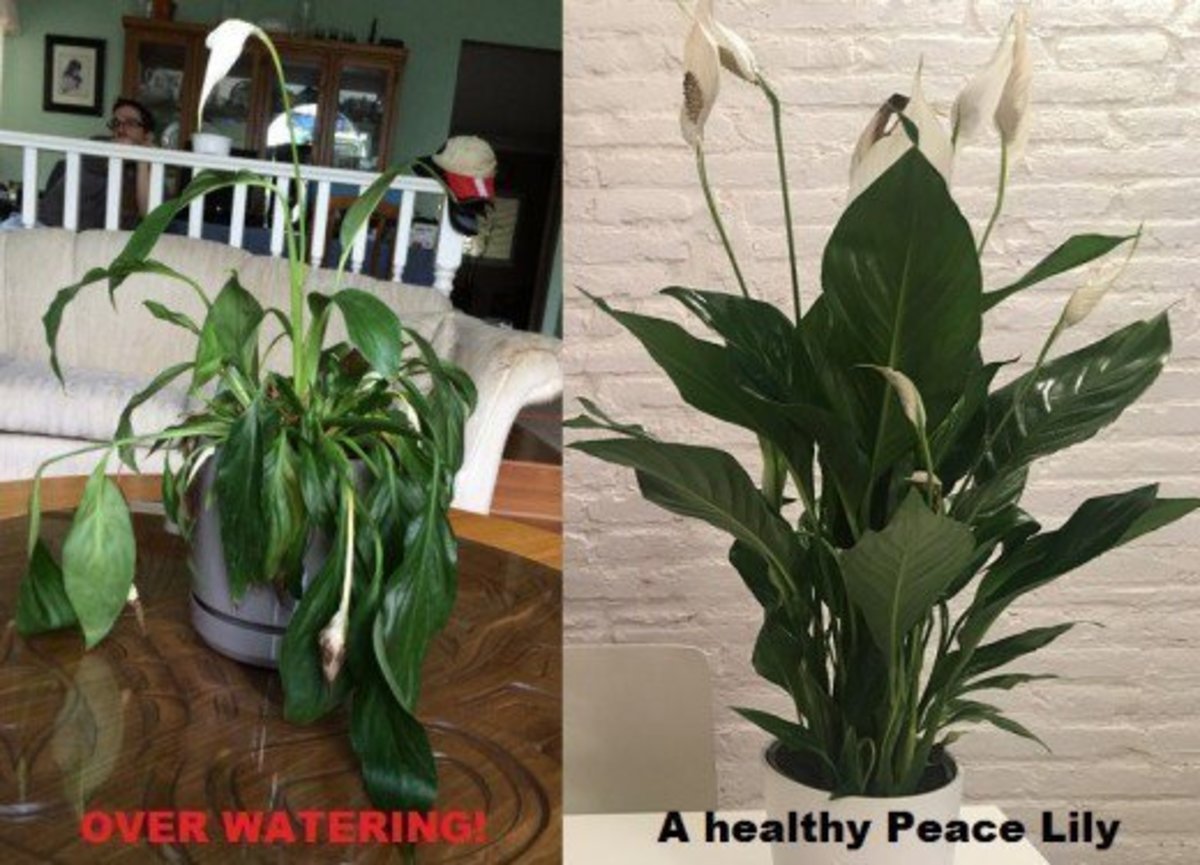One of the most beautiful house plants in the plant world is the Peace Lily. The deep, dark green foliage and bright white flowers are signature trademarks of these wonderful plants and, as perennials, they bloom all year round! Their leaves reach an average of 12 inches long, and the white snowy blossoms can make an appearance at anytime.
Peace Lily's are often given as gifts for graduation parties, social gatherings, weddings, and birthdays.They became known as being representative of peace. This is partially because of the calming aromas the plant puts off as well as its bright white flowers (white flags are known internationally as the sign for cease fire in war time).
There are a few main aspects about caring for this wonderful plant that you will want to make sure you have a basic understanding of. They are: lighting, soil conditions, watering, and the use of fertilizer. With even with a basic understanding of the conditions ideal for a Peace Lily, you can be relatively confident your plant will flourish for years to come!
| Aspect of Care: | Ideal Conditions: |
|---|---|
| Lighting | Low light is better, avoid direct sunlight. |
| Soil Conditions | Quality soil with good aeration and drainage. |
| Watering | Don't over saturate the soil. High humidity areas are preferred (i.e. in a steamy bathroom). |
| Fertilizer | Fertilize sparingly. It's easy to over do it. Brown leaves = too much fertilizer. |
| General Care Tips | Wet the leaves on occasion. A light mist or wipe with a damp cloth. |
1. Lighting
Peace Lily's are hardy plants and usually adapt to their environment. They thrive in low light and are not to be put in direct sunlight. Too much sun causes the plant to be stressed and results in the leaves turning yellow and brown. Natural light is a favorite of this plant, but they have been known to thrive in rooms without any windows. It is vitally important to keep them from cold drafts and freezing temperatures.
2. Soil Conditions
Potting soil should be of high quality. It should be well aerated with additional sand in the mixture. Allowing drainage holes in the pot will help prevent the roots from rotting, which is a common issue with these plants. A yearly check is advisable to make sure the plant has not become root bound. If this should become a problem, gently loosen up the roots with your fingers while transplanting it to a bigger pot.
3. Watering
The most common cause of killing any plant is over-watering. This is especially the case with the Peace Lily. This particular plant really thrives in a bathroom. Steamy bathrooms really quench their thirst and they don't mind the low light conditions (see lighting section above). The key to watering the plant is to spread out the watering sessions. Check the dampness of the soil about every week. If the top of the soil feels dry, it's time to give it some water. A rule of thumb is to give the plant enough to drink, but don't saturate it.

4. Use of Fertilizer
Should you decide to fertilize your plant there are some things to take into consideration. If you decide to feed your plant, use a well balanced fertilizer. Use this sparingly. You will know if you are fertilizing the plant too much if the leaves turn brown. A great alternative to traditional fertilizer is compost tea.
Should you choose traditional fertilizer, look for a fertilizer with approximately a 3:1:2 ratio for it's "NPK" numbers. NPK simply refers to the percentage of certain nutrients a plant uses and these numbers are almost always listed on the fertilizer's label.
So, an example of fertilizers with that 3:1:2 ratio that Peace Lily's prefer is any fertilizers labeled with "24-8-16", "9-3-6", or "12-4-8" on the packaging. This can be in the form of a standard solid fertilizer or in a liquid form.
Here is a little secret my green thumbed mother taught me. Jobe’s Organics Vegetable & Tomato Fertilizer (which is a 3-1-2 water soluble fertilizer mix), although it says it's formulated for vegetables, it does absolute wonders for Peace Lily's! If you need to pull out the "big guns" to get your plant to flower, this is what you'll need. Sometimes just fertilizing it once with this stuff will wake your plant up and it will start flowering on its own from then on.
When using this on Peace Lily's, make sure you dilute the formula even more than it says on the packaging. For Peace Lily's, use only a half scope of this fertilizer per one gallon of water and always fertilize when the soil is somewhat damp.
General Care Tips
Every few days wipe down the plant with a soft, damp cloth. A little tender loving care goes a long way and helps keep your plant in check. Once a week check for any old or dead foliage and trim it off. Removing the dying or dead flowers will ensure new growth. Also, give it a mist of warm water to provide extra moisture and stimulate growth.
Conclusion
The Peace Lily is a beautiful plant and will bring a lot of enjoyment. Remember, it is in the spathiphyllum family of plants. So while this plant is beautiful in appearance, it can be toxic to pets and humans alike. Keep this in mind when choosing the location of your plant. The Peace Lily is one of the more easy plants to care for and can bring many years of beautiful flowers and a wonderful fragrance.
Reader's Poll:
What aspect of caring for your Peace Lily do you struggle with?
Original article and pictures take wolfy.hubpages.com site
Комментариев нет:
Отправить комментарий